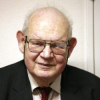Benoit Mandelbrot

Benoit Mandelbrot
Benoit B. Mandelbrot was a Polish-born, French and American mathematician with broad interests in the practical sciences, especially regarding what he labeled as "the art of roughness" of physical phenomena and "the uncontrolled element in life." He referred to himself as a "fractalist". He is recognized for his contribution to the field of fractal geometry, which included coining the word "fractal'", as well as developing a theory of "roughness and self-similarity" in nature...
NationalityFrench
ProfessionMathematician
Date of Birth20 November 1924
CountryFrance
I've been a professor of mathematics at Harvard and at Yale. At Yale for a long time. But I'm not a mathematician only. I'm a professor of physics, of economics, a long list. Each element of this list is normal. The combination of these elements is very rare at best.
The beauty of what I happened by extraordinary chance to put together is that nobody would have believed that this is possible, and certainly I didn't expect that it was possible. I just moved from step to step to step.
Humanity has known for a long time what fractals are. It is a very strange situation in which an idea which each time I look at all documents have deeper and deeper roots, never (how to say it), jelled.
It was astonishing when at one point, I got the idea of how to make artifical clouds with a collaborator, we had pictures made which were theoretically completely artificial pictures based upon that one very simple idea. And this picture everybody views as being clouds.
The theory of chaos and theory of fractals are separate, but have very strong intersections. That is one part of chaos theory is geometrically expressed by fractal shapes.
Both chaos theory and fractal have had contacts in the past when they are both impossible to develop and in a certain sense not ready to be developed.
In mathematics and science definition are simple, but bare-bones. Until you get to a problem which you understand it takes hundreds and hundreds of pages and years and years of learning.
My life has been extremely complicated. Not by choice at the beginning at all, but later on, I had become used to complication and went on accepting things that other people would have found too difficult to accept.
I had many books and I had dreams of all kinds. Dreams in which were in a certain sense, how to say, easy to make because the near future was always extremely threatening.
If one takes the kinds of risks which I took, which are colossal, but taking risks, I was rewarded by being able to contribute in a very substantial fashion to a variety of fields. I was able to reawaken and solve some very old problems.
I didn't feel comfortable at first with pure mathematics, or as a professor of pure mathematics. I wanted to do a little bit of everything and explore the world.
Everything is roughness, except for the circles. How many circles are there in nature? Very, very few. The straight lines. Very shapes are very, very smooth. But geometry had laid them aside because they were too complicated.
When people ask me what's my field? I say, on one hand, a fractalist. Perhaps the only one, the only full-time one.
One of the high points of my life was when I suddenly realized that this dream I had in my late adolescence of combining pure mathematics, very pure mathematics with very hard things which had been long a nuisance to scientists and to engineers, that this combination was possible and I put together this new geometry of nature, the fractal geometry of nature.